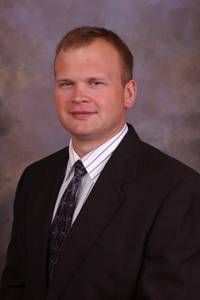
John Holman, PhD
Professor
Cropping Systems Agronomist
SW Research and Extension Center
4500 East Mary Street
Garden City, KS 67846
Ph: 620-276-8286
Dr. John Holman is a Professor in the Agronomy Department and serves as the Cropping Systems and Forage Agronomist in western Kansas. Dr. Holman earned a bachelor’s degree in Agronomy and Agriculture Business and a master’s degree in Weed Science from Montana State University, and a PhD in Plant Science from the University of Idaho. From 2002 to 2006, he worked as a research and extension scientist for the University of Idaho. He joined Kansas State University in 2006. Dr. Holman’s research program is focused on integrated crop/livestock cropping systems, dryland crop production, cover crops, and increasing water use efficiency to improve sustainability and profitability.
Current Projects
Wheat
- Radio Interview (MP3)
K-State research agronomist John Holman talks about his new analysis of climate conditions historically and how they have influenced wheat yields in western Kansas...using over 50 years of K-State field data to determine how temperature and precipitation impacted yield trends over time.
Canola
- Canola Production Handbook (PDF)
Canola is a special type of rapeseed. It differs from standard or industrial rapeseed because it has less than 2 percent erucic acid in the oil and less than 30 micromoles glucosinolate per gram of the oil-free meal. These two quality standards allow canola oil to be used as a healthy cooking oil and the meal as a high-quality protein supplement for livestock. - National Winter Canola Variety Trial
From 2006 to 2022, Garden City was a location of the National Winter Canola Variety Trial. Results are available annually on variety performance across the central Great Plains.
Cropping Systems
- Efficient Crop Water Use In Kansas (PDF)
Introduction: The Great Plains is an important center of agricultural production for both the United States and worldwide grain export. However, it is also a region that has numerous challenges to the sustainability of agricultural production, including soil losses from erosion, low precipitation in the west, intense thunderstorms, and declining aquifer levels that threaten availability of water for irrigation. - Volunteer Corn in Fallow (PDF)
Volunteer corn is a common weed in the fallow phase of wheat-corn-fallow in western Kansas and the west central Great Plains. No-till increases precipitation storage, reduces soil erosion, and often increases crop yields when compared to conventional-till. As a result, many producers have adopted no-till cropping systems that use glyphosate extensively for weed control in fallow. Because most of the corn grown is herbicide-tolerant, volunteer corn in fallow may not be controlled with glyphosate. - No-till Series: Rotations and Cultural Practices (PDF)
Introduction. A crop rotation system with optimal intensity and diversity is important for success with no-till. Without a sufficiently intense cropping system, no-till may not be profitable. Likewise, cropping systems that are too intensive can fail without no-till or some other high-residue production system in regions such as central and western Kansas that are prone to moisture stress.
Fallow Alternatives: Cover Crops, Annual Forages, and Grain Crops
- Soil Moisture: Managing a Limited Resource Wisely (Microsoft PowerPoint)
A slide presentation given by John Holman at 2013 3I show. - 2013 Cover Your Acres Presentation (PDF)
A slide presentation given by John Holman at 2013 Cover Your Acres.
Forages
- Summer Annual Forages: Production and Management Presentation (PDF)
Summer annual forages are an important resource for the region’s livestock industry. Knowledge of different forage types, production and feeding systems, and best management practices are important for successful forage production. This presentation provides an overview of important considerations and current research projects. - Kansas Switchgrass Production Handbook (PDF)
Switchgrass (Panicum virgatum L.) is a warmseason perennial grass indigenous to the North American tall-grass prairie but is widely distributed throughout the continent. Switchgrass was identified by the U.S. Department of Energy as a leading potential cellulosic bioenergy crop due to its large biomass production and wide range of geographical adaptation. Learn more about its usage in Kansas. - Prussic Acid Poisoning (PDF)
Prussic acid is also known as hydrocyanic acid or hydrogen cyanide (HCN). Ingesting plants that have produced excess cyanide causes prussic acid poisoning. Sorghums, sudangrass, sorghum–sudangrass crosses, and closely related species are most commonly associated with prussic acid poisoning. - Nontraditional Forages as Emergency or Supplemental Feedstuffs (PDF)
Despite the best plans, shortages of forage commonly occur some time during the year in Kansas. Drought, hail, early freeze, crop failure, harvest delays,
and unusually cold and wet winters can cause forage shortages. In response, producers may choose to buy the extra forage needed or sell livestock. But in many cases, it may be more economical to use nontraditional forages. The following document summarizes several options for obtaining forage from nontraditional sources or in emergency situations generated by an unexpected shortage of forage. - Summer Annual Forages: Selection and Production Characteristics (PDF)
Summer annual forages are warm-season grasses that tolerate hot, dry weather and are adapted to most areas of Kansas. Although most species should not be planted until the soil temperature reaches 70 degrees to 75 degrees Fahrenheit, some can be used by 4 to 6 weeks after planting. Summer annual forages include forage sorghums, sudangrass, sorghum-sudangrass hybrids, hybrid pearl millet, and foxtail millet (a.k.a. Italian, German, Hungarian, or Japanese Millet). Selecting a type of summer annual should be based on the needs and location of the individual livestock program because they have different growth characteristics that influence how they are used. The following document summarizes characteristics of the most commonly used summer annual forages used in Kansas.
Previous Projects
- Kentucky Bluegrass Production Handbook (PDF) University of Idaho Extension Publication
- Kentucky Bluegrass Growth, Development, and Seed Production (PDF) University of Idaho Extension Publication
- Kentucky Bluegrass Seed Production Systems - Economic Assessment (PDF) University of Idaho Extension Publication
- Persian Darnel: Identification, Biology, and Ecology (PDF) Montana State University Extension Services